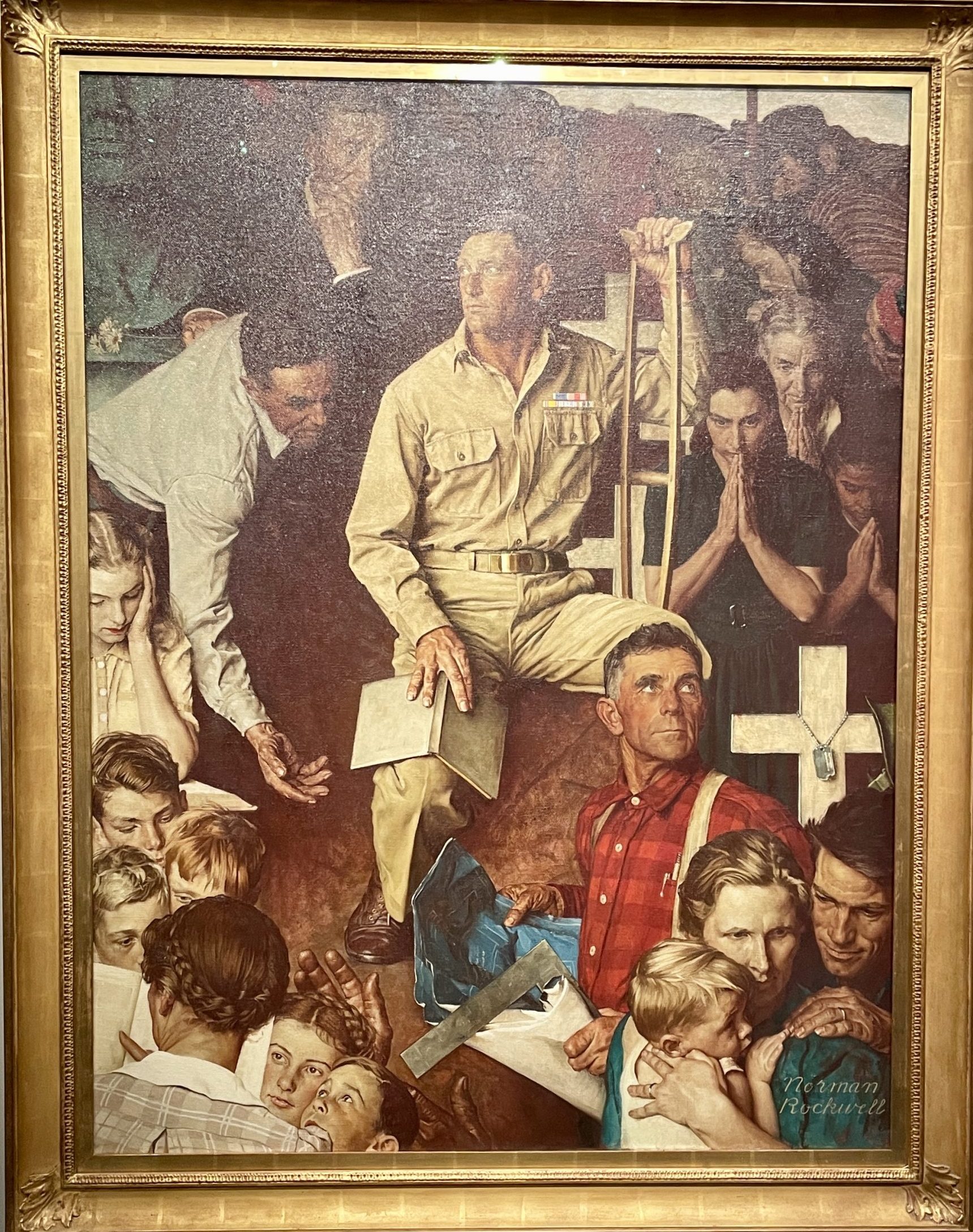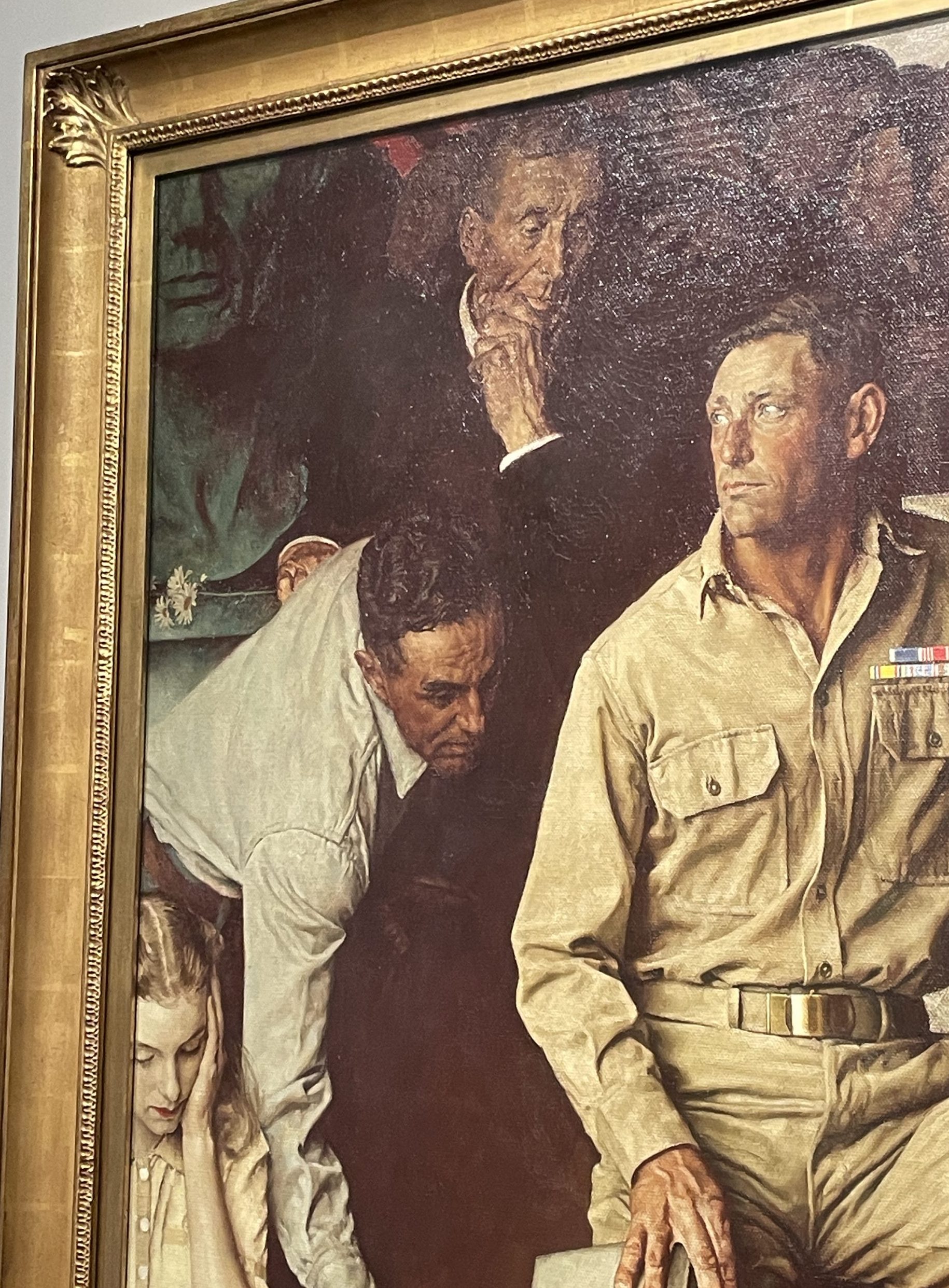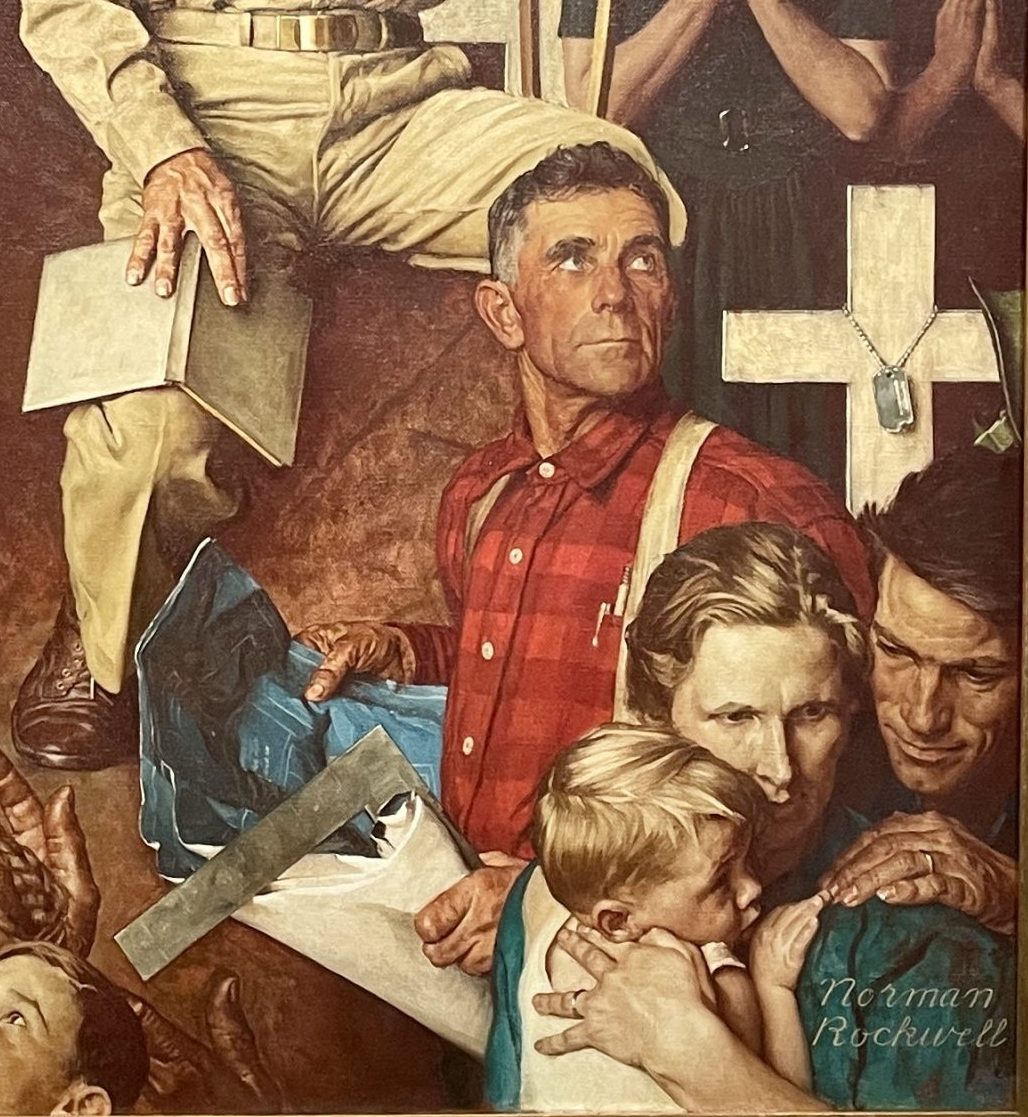“The Long Shadow of Lincoln” as portrayed in Norman Rockwell’s Painting and Carl Sandburg’s Poem in 1945

Tucked away in California’s Inland Empire stands the only memorial to Abraham Lincoln west of the Mississippi River. Built in 1932 in the city of Redlands, the Lincoln Memorial Shrine is a hidden gem that is definitely worth a visit. Sarah Kay Bierle wrote an excellent post in 2016 providing some background on how this unexpected memorial ended up in California and describing some of the artwork and artifacts visitors can peruse in the museum, including many items and documents from the Civil War.
One painting in particular stood out to me during a recent visit, and it is among the most popular items in the Lincoln Memorial Shrine’s holdings. Originally created by Norman Rockwell for the February 10, 1945 issue of the Saturday Evening Post, the painting – titled The Long Shadow of Lincoln – was donated by Rockwell to the shrine in May 1945 and has been hanging in a place of honor ever since. As we celebrate the 215th anniversary of President Abraham Lincoln’s birth, it seems a fitting time to examine how his “shadow” is still felt today and consider why the publishers of the Saturday Evening Post chose to highlight Lincoln in their 1945 issue.

By February 1945, victory for the U.S. and its Allies over Nazi Germany and Imperial Japan finally seemed in sight. With this in mind, the publishers of the Saturday Evening Post, Curtis Publishing Company, “took the occasion of Abraham Lincoln’s birthday in February 1945 to ponder the peace about to fall over the world’s warring nations and the uncertain future. As the instruments of this message, they chose America’s foremost poet, Carl Sandburg, and paramount artist, Norman Rockwell.” [1]
Sandburg had already proven he was well acquainted with Lincoln, having spent decades researching and writing his two-volume Abraham Lincoln: The Prairie Years (1926) and his four-volume Abraham Lincoln: The War Years (1939), which won the 1940 Pulitzer prize. Rockwell’s artwork had been featured on the cover of the Saturday Evening Post many times, beginning with his first cover painting in 1916 and going on to include 322 paintings over the next 47 years. [2] His 1943 series of paintings on “The Four Freedoms,” based on Franklin D. Roosevelt’s 1941 State of the Union Address, showed how well he could capture a president’s words and message in paint and reflected his desire to help the war effort. For this particular painting, Rockwell drew inspiration from Sandburg’s poem, as well as the publisher’s theme, “Thoughts on Peace on Lincoln’s Birthday.”
But he also looked to Lincoln himself for inspiration, as did Sandburg. Rockwell drew from the last paragraph of Lincoln’s Second Inaugural Address: “With malice toward none; with charity for all; with firmness in the right, as God gives us to see the right, let us strive on to finish the work we are in; to bind up the nation’s wounds; to care for him who shall have borne the battle, and for his widow, and his orphan – to do all which may achieve and cherish a just and a lasting peace, among ourselves, and with all nations.”
In their introduction to the feature article, the Post editors offered some explanations of his painting: “In the heart-lifting symbolism of Norman Rockwell’s great painting there is thought for all of us. For here we find not only the crippled soldier who must learn a new way of life, the builder who will help put a shattered world together, the teacher and her brood, and the sorrowing family of a fallen warrior, but also the hand of brotherhood extended to the downtrodden and, in the background, the less fortunate races of humankind who must not be forgotten if peace is to be anything more than an armistice. Here, in the faces and attitudes of these people, are determination and tolerance and the yearning for a better world.” [3]
Treasures of the Lincoln Memorial Shrine, edited by Don McCue, presents further interpretations: “The central focus of the painting is a disabled soldier, newly returned from the battlefield, who is contemplating the challenges of the postwar world. He has sought inspiration in the words of Abraham Lincoln as exemplified by the open book on his knees. Meant to be a popular biography of Lincoln, Rockwell later claimed he left the title off the book because he disliked using printed letters in his illustrations. The soldier gazes almost wistfully towards the bust of Lincoln in the upper corner.” [4]
All around the soldier are symbolic representations of “the blessings of liberty for which Americans were fighting,” including freedom of worship (center right), the family unit (bottom right), universal education (bottom left), and racial brotherhood (seen in the white hand reaching toward the black hand on the left). Because of Rockwell’s belief that further work was needed to achieve racial equality, the black man does not appear in the picture. In the top right, the great masses of refugees walk toward Lincoln, looking for a place where they will be welcome no matter their race, color, or creed. The cross, dogtags, and helmet serve as a reminder that war comes at a heavy cost.
The significance of the man with his hand under his chin in the top left is a subject for debate, with some believing it represents Rockwell himself. According to curators at the Lincoln Memorial Shrine, however, “the most important symbol is the wounded soldier’s amputated left leg. It is obscured by the builder with his blueprints, demonstrating Rockwell’s belief that through the sacrifice of World War II a better, stronger world would be built.” [5]

In his poem for the Saturday Evening Post, titled “The Long Shadow of Lincoln: A Litany,” Sandburg draws inspiration from Lincoln’s concluding remarks in his Message to Congress on December 1, 1862. Sandburg incorporates the line “We must disenthrall ourselves” twice in his poem – the same words used by Lincoln in his urgent call to action. To “disenthrall” means to liberate or set free, and Lincoln’s use of the word can be interpreted as referring to both freeing the slaves and freeing the nation from its old ways of thinking.
The speech itself, presented one month before Lincoln signed the Emancipation Proclamation, aimed to rouse and reinvigorate Congress after the bloody battle of Antietam. Though its controversial measures, such as compensated emancipation and voluntary colonization of slaves, were criticized by many Northern abolitionists and were not ultimately supported by Congress, his concluding remarks highlighted the need for new ways of thinking to help the country move forward. Lincoln asserted, “The dogmas of the quiet past are inadequate to the stormy present. The occasion is piled high with difficulty, and we must rise with the occasion. As our case is new so we must think anew and act anew. We must disenthrall ourselves, and then we shall save our country.” [6]
In his tribute poem to Lincoln, Sandburg opens by calling on his audience to “Be sad, be cool, be kind, / remembering those now dreamdust / hallowed in the ruts and gullies / solemn bones under the smooth blue sea, / faces warblown in a falling rain” (Sandburg, lines 1-5). Sandburg saw many parallels between his own present time of WWII and the Civil War, and in his poem. he identifies the need for each person to “be a brother, if so can be, / to those beyond battle fatigue / each in his own corner of earth” (6-8).
He captures the tragedy of war by acknowledging that many, each with their own “pack of secrets” and “personal dream[s], are now “forty fathom underseas / beyond all boom of guns” or face “long endless winds with … the hush and sleep murmur of time” (13-14, 9-10, 15-17). Again he repeats the need to “be a brother,” for:
There are wounds past words.
There are cripples less broken
than many who walk whole.
There are dead youths
with wrists of silence
who keep a vast music
under their shut lips,
what they did being past words,
their dreams like their deaths
beyond any smooth and easy telling,
having given till no more to give (37-47).
These returning soldiers, he emphasizes, will need support – so we must “sing low, sing high, sing wide, making “wit a guard and cover” and letting our “laughter come free / like a help and a brace of comfort” (18/20). Then, Sandburg speaks of Lincoln, who steps “out of a granite tomb, / out of a bronze sarcophagus, / loose from the stone and copper,” and “lift[s] an authoritative hand / in the name of dreams worth dying for” (59-62, 64-65). He reminds the men on the field that their fight is worthwhile, and though what they are doing is “past words” and “beyond all smooth and easy telling,” they must continue “looking toward peace / by the light of the hard old teaching: ‘We must disenthrall ourselves’” (81-83). We must free ourselves from fighting, war, hatred, regret, and old ways of thinking, “with old timetables, / old maps, old guide-posts / torn into shreds” (52-54), thus enabling us to build a better world for tomorrow.
Sandburg continued to write and speak about Lincoln through his life, including a Lincoln Tribute in 1962 on the Ed Sullivan Show that can be viewed HERE. Towards the end of this tribute, he states, “We might be asking in the present hour, what is the greatest single result from our Civil War related to the present hour of fate and history? It could be that the answer is we are a united power, a united powerful nation, and our power, it rests chiefly in our unity. Our nation of unbreakable United States is the foremost contender for freedom for all men the world over.” [7]
As we remember Lincoln on his 215th birthday from the vantage point of living in a nation that often seems quite divided today, we might do well to ponder Rockwell’s painting and Sandburg’s words and remember there is great strength in unity and brotherhood.

Endnotes:
- Lincoln Memorial Shrine (Redlands, Calif.). Treasures of the Lincoln Memorial Shrine. Edited by Don McCue, Watchorn Lincoln Memorial Association, 2008.
- “Norman Rockwell Biography.” The Saturday Evening Post, https://www.saturdayeveningpost.com/norman-rockwell-biography/.
- “President Lincoln Archives.” The Saturday Evening Post, https://www.saturdayeveningpost.com/sep-keyword/president-lincoln/.
- Lincoln Memorial Shrine (Redlands, Calif.). Treasures of the Lincoln Memorial Shrine. Edited by Don McCue, Watchorn Lincoln Memorial Association, 2008.
- Ibid.
- “Abraham Lincoln’s Annual Message to Congress – Concluding Remarks.” Abraham Lincoln Online, https://www.abrahamlincolnonline.org/lincoln/speeches/congress.htm.
- “Carl Sandburg “Recites His Civil War Address” on The Ed Sullivan Show.” YouTube, 19 November 2021, https://www.youtube.com/watch?v=J4QgzAgOF_w.
This reminds me of a never forgotten event in my life. When I was 5 my mother took me to the barber shop for a hair cut. The barber placed a board across the arm of the chair, so I would sit higher for my hair cut. Now the barber said if I sat real still he would let me put my finger in his leg. I was so surprised by this that I was a statue. When he was done to my mother’s satisfaction, he pulled up his pant leg and there was a wooden leg! It had a hole and in my finger went. He lost his leg during World War 2.
I can see why that would leave a significant impression on you as a five year old. A clever way to get kids to sit still for their hair cut!
Awesome interpretation! It seems like Rockwell’s painting transcends almost all of American history.
Thanks, Evan! I meant to respond to your post on “The Saddest Christmas” but never got a chance. I found it interesting that your post and mine from Dec. 24th used the same picture for two very different topics – and it was so relevant to both.
Very well written and moving. Thank you.